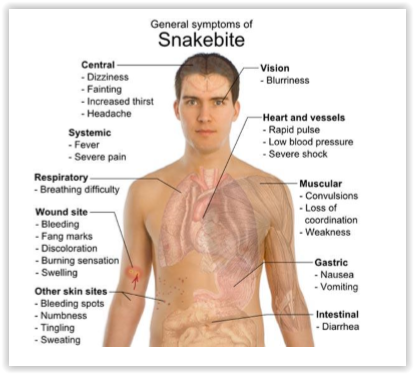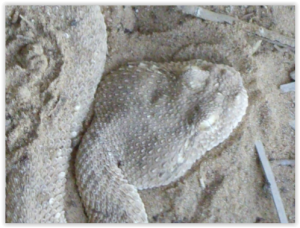Danger after the bite:
1) Ensure you and the casualty are safe and the snake is not still close.
2) As far as the snake is concerned – do not attempt to kill it as this may be dangerous. However, if the snake has already been killed, it should be taken to the hospital with the patient in case it can be identified. However, do not handle the snake with your bare hands as even a severed head can bite up to one hour after its death!
3) Take a note of the time.
4) Check that the casualty did see it was a snake that bit them. This could be a rodent or Lizard or even a thorn.
5) The snakebite victim should be transported as quickly and as passively as possible to the nearest place where they can be seen by a medically-trained person
First-aid treatment Principles of first-aid:
- Remain calm, Reassure the casualty who may be very anxious
Immobilize the bitten arm or leg, and stay as quiet as possible to keep the poison from spreading through your body too fast. - Remove jewellery before any swelling starts. ( Give jewellery to casualty to hold ) • Position yourself, if possible, so that the bite is at or below the level of your heart.
- Apply a splint to reduce movement of the affected area, but keep it loose enough so as not to restrict blood flow. Use a compression bandage in attempt to slow venom movement only.
- Don’t use a tourniquet or apply ice.
- Don’t cut or suck the wound or attempt to remove the venom, rubbing, vigorous cleaning, massage, application of herbs or chemicals.
- Don’t drink caffeine or alcohol.
- Don’t try to capture the snake, but try to remember its colour and shape so you can describe it in the Hospital, this will help in your treatment. (take a photo) but do not waste time in doing so . Remember the circumstances of the event, where the casualty was type of area are important as identification of the snake might be done like this..
- If EMS are available, do not move the patient, monitor breathing and coconsciousness, note changes or on set of symptoms with the time. This might help the Hospital.
- Be prepaid to treat for shock, keep them calm.
- In a small number of people, a snake bite can trigger a severe reaction, known as anaphylaxis or anaphylactic shock.
- Be ready to put in recover position and monitor breathing, should they stop breathing undertake CPR till EMS get there.( re- phone EMS with significant changes).
- If EMS are NOT available, take a few mins to assess your best options to move the patient with least amount of movement and fastest way to a road. Get transport in position close and ready to move to hospital. Try get them out without walking.
- Alert the hospital your arriving with snake bite victim or EMS to meet you at nearest position ( send your WhatsApp or Google position by mobile)
Symptoms and signs of snake-bite when venom has not been injected
Not all snake bites involve the discharge of venom into the victim (known as envenomation). At least 25% of poisonous snake bites do not result in envenomation.
Some people who are bitten by snakes or suspect or imagine that they have been bitten, may develop quite striking symptoms and signs even when no venom has been injected. This results from an understandable fear of the consequences of a real venomous bite. Anxious people may over-breathe so that they develop pins and needles of the extremities, stiffness or tenderness of their hands and feet and dizziness. Others may develop shock after the bite or suspected bite-faintness and collapse with profound slowing of the heart.
When venom has been injected; early symptoms and signs

Local symptoms and signs in the bitten part:
- fang marks
- local pain
- local bleeding
- bruising
- lymphangitis (raised red lines tracking up the bitten limb)
- lymph node enlargement
- inflammation (swelling, redness, heat)
- blistering
- local infection, abscess formation
- necrosis
VENOM
Snakes may have a mixture of toxins to make up their venom. There are approximately 20 types of toxic enzymes found in snake poisons throughout the world known to man. Although no venomous snake has all of these toxins, most snakes employ between six to twelve of these enzymes in their venom. Each of these enzymes has its own special function. Some aid in the digestive process, while others specialize in paralysing the prey.
Read more here.
- Proteolytic venom dismantles the molecular structure of the area surrounding and including the bite.
- Hemotoxic venoms act on the heart and cardiovascular system. Procoagulants intravascular coagulation leading to circulatory arrest, anticoagulants; the net effect of most of these toxins is to increase bleeding
- Neurotoxic venom acts on the nervous system and brain, causing paralysis • Cytotoxic venom has a localized action at the site of the bite.
- Myotoxins Dissolution or liquefaction of muscular tissue.
(It is noteworthy that the size of the snake or venom fangs is in no relation to the virulence of the venom.)
Venomous Oman snakes
- Oman saw-scaled viper (Echis omanensis). Click here.
- Sind Saw-scaled viper, known as Burton’s carpet viper an aggressive snake. Click here.
- Arabian horned viper (Cerastes gasperettii) Click here.
- Persian horned viper (pseudocerastes persicus) Also known as false horned viper Persian horned viper is named for the pair of prominent, scale-covered “horns” above its eyes. The Persian horned viper resembles the Arabian horned viper (cerastes gasperettii) in appearance, but its “horns” are made up of many small scales, rather than a single elongated scale. Click here.
“Venom of these snakes acts as an anti-coagulant that could lead to excessive bleeding, necrotising (death of tissue), and anticoagulant (preventing the blood from clotting)
All species in the family Viperidae, the viper has large venom is aggressive and are capable of injecting large quantities of venom.
- Arabian cobra (Naja haje Arabica) consists mainly of neurotoxins and cytotoxins.
The elapines, short front fangs (Proteroglyphs) snakes, which include the cobra, mamba, and coral snakes, their venom is neurotoxic (nerve toxins) and paralyses the respiratory centre.
Monovalent / polyvalent antivenom Snake antivenom can be classified by which antigens (venoms) were used in the production process. If the hyperimmunizing venom is obtained from a single species, then it is considered a monovalent antivenom. If the antivenom contains neutralizing antibodies raised against two or more species of snakes, then the composition is considered polyvalent. Snake Antivenom is a mixture of hyperimmune globulins and other proteins obtained from the serum of animals (horses, sheep) that have been immunized with the venom of a snake.
WHO Guidelines for the Production, Control and Regulation of Snake Antivenom Immunoglobulins.
Hospital treatment
The hospital will test you first to ensure there is no reaction before injecting Antivenom, also protection from anaphylactic shock. It should be given intravenously, through a drip set.
If you would like to down load a copy please click here, ( note We will keep the PDF updated)

